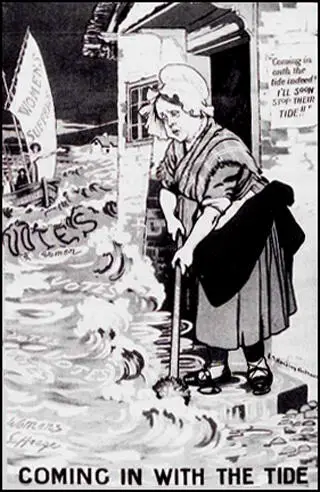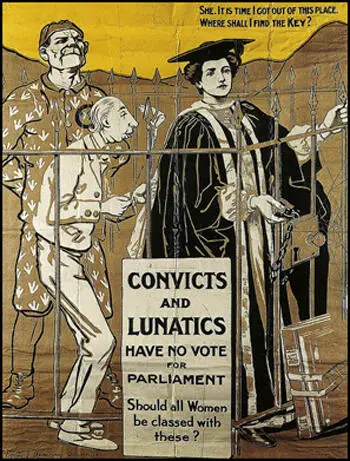Emily Harding Andrews
Emily Jane Harding, the eldest of the several children of Thomas Giles Harding, a commercial traveller, and his wife, Rosa Jane (nee May) was was born in 1851 at Clifton in Bristol. Emily and her sister, Rosa Elizabeth Harding, were educated at Clifton Ladies' College and Bristol School of Art. (1)
In around 1880 Emily married a fellow artist, Edward William Andrews. The following year Emily and her husband were living, with one servant, at 23 Iverson Road, Hampstead. By 1891 they had moved to Chalcot Gardens, Hampstead but no servant. In 1901 they were living in a flat in 95 Fitzjohn's Avenue, Hampstead. (2)
During this period Andrews produced illustrations for a series of books – mainly for children. They included Bright Pages for Children of All Ages (1886), The Little Ladies (1890), Merry Moments for Little Folks (1893) Disagreeable Duke (1894) and Lullabies of Many Lands (1894). (3)
Andrews was a supporter of woman's suffrage and in 1907 joined the National Union of Suffrage Societies (NUWSS). She became involved with the Artists' Suffrage League (ASL). The organisation was founded by professional women artists to help with the preparations for the first large-scale public demonstration by the NUSS being planned for the summer of 1908. (4)
The Artists' Suffrage League published "Mrs Partington: Coming in with the Tide" by Andrews. As Lisa Tickner, the author of The Spectacle of Women: Imagery of the Suffrage Campaign (1987) has pointed out: "Mrs Partington was a Canute-like figure - said to have tried to sweep back the ocean after a storm - whose story had already been used in debates on the 1832 Reform Bill to suggest the futility of trying to stem the tide of social progress." (5)

In 1908 Andrews entered a NUSS competition but according to the Women's Franchise newspaper she took a joint second place, sharing the £5 prize with a Miss Williams. The judges commented that they found it impossible to decide on which was the better, Miss Williams's design being the more artistic, while Mrs Andrews' would reproduce better". Dora Meeson Coates took the first prize. (6)
Andrews produced the famous poster, Convicts lunatics and women! Have no vote for parliament: Is it time I got out of this place - Where shall I find the KEY?. It showed a woman wearing cap and gown standing inside locked gates with a convict and a lunatic. The ASL published the poster in 1908. It proved so popular that it was reprinted in 1910. "The strong image, dominated by the glamorously dignified woman graduate, did indeed reproduce well in colour and was also published by the ASL as a black and white postcard." (7)

Emily Harding Andrews did not have any children. Apparently she laughed at the very idea of having children and was reported to have said "What? Have children? We haven't got time for children!" Edward Andrews died in 1915. He left £160; his wife is not named as an executor. This suggested they had separated. In August 1935, aged 85, she moved to Australia to live with her widowed sister.
Emily Harding Andrews died in Sutherland, NSW, in August 1940.
Primary Sources
(1) Elizabeth Crawford, Emily J. Harding Andrews (21st November, 2014)
She was born Emily Jane Harding in 1851 at Clifton in Bristol, the eldest of the several children of Thomas Giles Harding (1827-1899), a commercial traveller, and his wife, Rosa Jane (nee May). Emily and her sister, Rosa Elizabeth Harding, were educated at Clifton Ladies' College and in October 1868 both gained certificates of art in the second grade in a prize giving at the Bristol School of Art....
By the time the 1881 census was taken Emily was married to a fellow artist, Edward William Andrews – although I cannot find a record of the marriage. He was ten years older than her and had been born in Kidderminster. By the time he was 21 was describing himself on the census form as ‘Artist portrait painter'.
In 1881 Emily and her husband were living, with one servant, at 23 Iverson Road, west Hampstead. By 1891 they had moved to Chalcot Gardens, Hampstead, an area popular with artists, and now had no servant. In 1901, still fending for themselves, they were living in a flat in 95 Fitzjohn's Avenue, Hampstead.
Through the 1880s and 1890s Emily produced illustrations for a series of books – mainly for children. They included Bright Pages for Children of All Ages, 1886, Helen Milman's The Little Ladies, 1890, Merry Moments for Little Folks by Rose E May, published by Frederick Warne, 1893. Emily's sister, Rosa (or Rose) had married Frederick Lamartine May, son of a well-known bookseller, and a relation on their mother's side. She also provided the illustrations for Disagreeable Duke: a Christmas whimsicality for holiday boys and girls by Elinor Davenport-Adams, published by George Allen, 1894 and in the same year for Lullabies of Many Lands by the editor and translator Alma Strettell.
(2) Elizabeth Crawford, Art and Suffrage: A Biographical Dictionary of Suffrage Artists (2018)
"Convicts lunatics and women! Have no vote for parliament: Is it time I got out of this place - Where shall I find the KEY?" that was published by the ASL c. 1908 and proved so popular that it was reprinted, with slight alterations to the placing of the text, in 1910. The strong image, dominated by the glamorously dignified woman graduate, did indeed reproduce well in colour and was also published by the ASL as a black and white postcard."
(3) Helen Robertson, Emily J. Harding Andrews (1st June, 2015)
Emily was my great Aunt. I have several of her books and a hand written manuscript and original artworks for the draft book. Did you know she was fluent in many languages & lived in Switzerland & Austria before the war? She also worked for "the gvt" during the war translating coded messages that had been intercepted! She was very adventurous even in old age! She was a lot better off than you seem to imagine. I think she may have been a gvt agent for quite some time!
References
(1) Elizabeth Crawford, Emily J. Harding Andrews (21st November, 2014)
(2) Elizabeth Crawford, Art and Suffrage: A Biographical Dictionary of Suffrage Artists (2018) page 35
(3) Elizabeth Crawford, Emily J. Harding Andrews (21st November, 2014)
(4) Elizabeth Crawford, Art and Suffrage: A Biographical Dictionary of Suffrage Artists (2018) page 35
(5) Lisa Tickner, The Spectacle of Women: Imagery of the Suffrage Campaign (1987) page 41
(6) Women's Franchise (January, 1908)
(7) Elizabeth Crawford, Art and Suffrage: A Biographical Dictionary of Suffrage Artists (2018) pages 35-36

